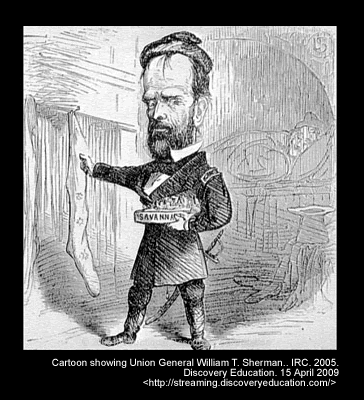The War Draws to an End

President Lincoln was impressed with General Grant's success in the West and brought him to the East to be the new General-in-Chief of Northern forces. His primary task was to bring the war to a close. Two of the three goals of the Anaconda Plan had been accomplished. The Mississippi River was now controlled by the Union and Northern naval blockades had cut the South off from most of European resources. General Grant's plans included capturing Richmond, destroying Atlanta and Savannah, thus breaking the South's will to prolong the war, and use his superior numbers to break the Confederate army.
Grant's Overland Campaign to capture Richmond was costly. The conflicts at the Wilderness, Spotsylvania, and Cold Harbor cost the Union army nearly 50,000 men. While previous Union commanders turned back to Washington D.C., General Grant continued into Virginia. Grant had a definite advantage over General Lee; he had superior numbers and resources. Grant laid siege to Petersburg and eventually it and Richmond fell. Meanwhile, General Sherman moved into Georgia, burning anything that could be used as resources. The city of Atlanta fell to Union troops in September 1864. Sherman waited until Lincoln's reelection and burned much of the city and began his "March to the Sea." Although Sherman's troops were under orders not to burn private property, Union troops burned and looted plantations and public buildings. Savannah fell in December 1864. General Sherman offered it as a Christmas present to President Lincoln.

General Sherman's March to the Sea left much of Georgia in ruins. In this cartoon, General Sherman presented Savannah to President Lincoln as a Christmas present in 1864.
Confederate troops were deserting by the thousands, as many saw the war as over. General Lee's remaining Army of Northern Virginia abandoned Richmond on April 2, 1865 and headed South to join General Johnston, who had been in North Carolina. General Grant however, prevented the two armies from meeting. General Grant sent General Lee a note inviting Lee and his army to surrender. On the morning of April 9, 1865, General Lee, dressed in his best uniform, met with General Grant at Wilmer McClean's house in Appomattox Court House, Virginia to discuss the terms of surrender. General Grant offered generous terms of surrender. He allowed the soldiers to keep their horses, side arms, and personal possessions. He guaranteed that they would not be prosecuted for treason and gave the Confederate soldiers three days rations. This simple "Gentlemen's Agreement" ended the four year long struggle in Virginia. Later that month, General Johnston surrendered to General Sherman in North Carolina. May 4th, General Richard Taylor surrendered in Citronelle, Alabama and June 2nd General Edmund Kirby Smith surrendered his Trans Mississippi units. The war was over.
Continue working on the 11.08 Civil War Crossword. You will turn it in at the end of the lesson.
"There is nothing left for me to do but to go and see General Grant, and I would rather die a thousand deaths."-Robert E. Lee
|
Click here to view the instructions for logging in to Discovery Education Streaming videos.
|

|
Did You Know?
Did you know that The University of Alabama became a military college during the war. It produced the Confederacy with:
- 7 generals
- 25 colonels
- 14 lieutenant colonels
- 21 majors
- 125 captains
- 273 staff and other commissioned officers
- 294 private soldiers.
Tuscaloosa had been lucky not to suffer damage earlier in the war, but on April 4, 1865 troops marched out to The University of Alabama and destroyed the campus by throwing "flammable torpedoes" into the doors and windows of the public buildings. By afternoon most of the University was in flames with the exception of the observatory which was somehow overlooked and several faculty houses. The President's Mansion was actually set on fire, but due to the bravery of Mrs. Garland, the fire was extinguished and the house allowed to remain.
Ironically, the small guard house, the only structure built on the campus with a specific military purpose, was not burned.
